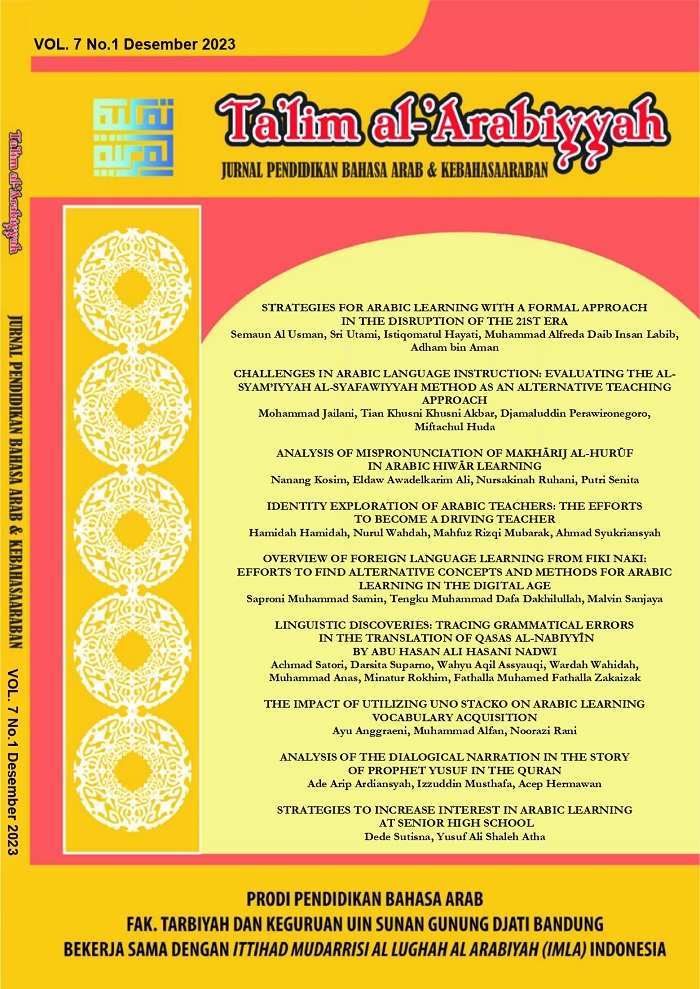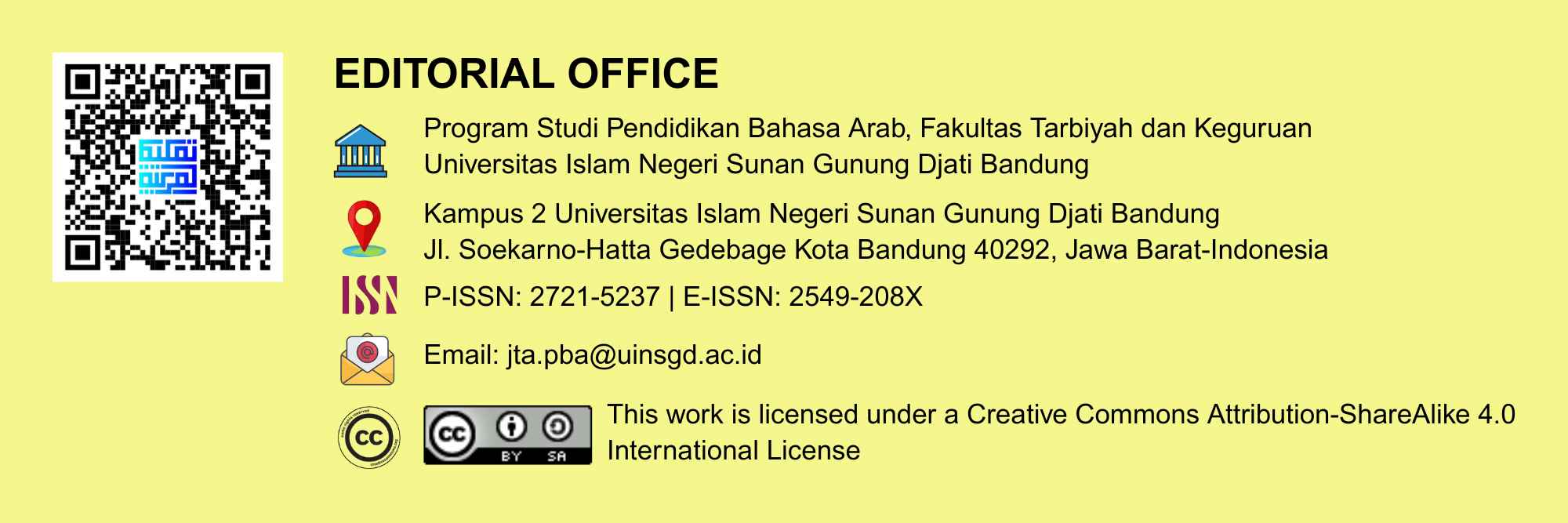Analysis of Mispronunciation of MakhÄrij Al-HurÅ«f in Arabic HiwÄr Learning
DOI:
https://doi.org/10.15575/jpba.v7i2.30124Keywords:
Errors, HiwÄr, MakhÄrij Al-HurÅ«f, Mispronunciation, PronunciationAbstract
This research aims to identify the locations of mispronunciations of the makhÄrij al-hurÅ«f in conversations (hiwÄr) in the VII PPS Babussalam class in the city of Bandung. Additionally, it serves as an evaluation tool for Arabic language learning to improve the learning process and provide solutions or treatments to students to enhance their makhÄrij al-hurÅ«f pronunciation. Correcting makhÄrij al-hurÅ«f errors is crucial as they can affect the meaning. This research utilizes a qualitative descriptive research method. The population of this research includes all the students in the VII PPS Babussalam class in the city of Bandung, and it was conducted on May 17, 2023, at the VII PPS Babussalam class in Bandung. Data collection involved interviews, tests, and documentation, followed by analyzing all data in narrative form. Based on the research findings, it can be concluded that there are 426 mispronunciations of makhÄrij al-hurÅ«f in the hiwÄr in the VII PPS Babussalam class in Bandung. These errors include mispronunciations in Al-Jauf (Mouth Cavity), totaling three errors with a percentage of 0.70%, falling into the deficient category; mispronunciations in Al-halq (Throat), totaling 204 errors with a percentage of 47.89%; falling into the high category; mispronunciations in al-lisÄn (Tongue), totaling 171 errors with a percentage of 40.14%, also falling into the high category; mispronunciations in al-syafatain (Two Lips), totaling 35 errors with a percentage of 8.22%, falling into the low category; and mispronunciations in Al-Khaiysyum (Nasal Cavity), totaling 13 errors with a percentage of 3.05%, falling into the low category. These pronunciation errors occur due to the student's lack of understanding of the correct makhÄrij al-hurÅ«f pronunciation, such as not being aware of the pronunciation differences between Indonesian and Arabic, the absence of specific attention from teachers to correct each student's pronunciation, and the lack of practice. This study recommends further research in analyzing the mispronunciation of makhÄrij al-hurÅ«f letters with different research objects, namely the mispronunciation of makhÄrij al-hurÅ«f letters in Arabic news.
References
Aini, N. (2018). The Grammatical Errors in the Translational Text: Indonesian-English Structure. Tell: Teaching of English Language and Literature Journal, 6(2), 55–61. https://doi.org/10.30651/tell.v6i2.2109
Akbari, M. Y. A. (2018). Arabic Error Analysis. Proceedings of the 1st International Conference on Intellectuals’ Global Responsibility (ICIGR 2017), 1, 168–171. https://doi.org/10.2991/icigr-17.2018.41
Algabri, M., Mathkour, H., Alsulaiman, M., & Bencherif, M. A. (2022). Mispronunciation Detection and Diagnosis with Articulatory-Level Feedback Generation for Non-Native Arabic Speech. Mathematics, 10(15), 1–24. https://doi.org/10.3390/math10152727
Alwan, M. D., & Maulani, H. (2023). Pronunciation of Syafatain in Surah Al-Fatihah: Phonetic Analysis of The Imam of The Mosque. Al-Fusha Arabic Language Education Journal, 5(1), 34–42. https://doi.org/10.36835/alfusha.v5i1.1090
Amin, S. (2021). Ilmu Tajwid Lengkap. el Ameen Publisher.
Amri, M. A. (2019). Ilmu Tajwid Praktis. Pustaka Baitul Hikmah Harun Ar-Rasyid.
Asih, R., Miftahuddin, A., & Elmubarok, Z. (2020). Analisis Kesalahan Fonologi Dalam Keterampilan Membaca Teks Berbahasa Arab Siswa Kelas XI SMA Islam Sultan Agung 1 Semarang. Jurnal of Arabic Learning and Teaching, 9(2), 81–88. https://doi.org/10.15294/la.v9i2.42655
Basid, A., Zayyadi, A., Husna, R., Billah, F. A., & Roziqin, J. (2022). Assistance Of Tahsin Al-Qur’an New Santri At Pondok Pesantren. Ijocore: Indonesian Journal of Community Research & Engagement, 1(01), 8–14. https://doi.org/10.15408/ijocore.vxix.xxxx
Daulay, N., Al Farabi, M., & Ulya, N. (2022). Implementation of Counseling Guidance Services in Overcoming Difficulties of Remindering The Al-Qur’an. KONSELI: Jurnal Bimbingan Dan Konseling (E-Journal), 9(1), 119–124. https://doi.org/10.24042/kons.v9i1.10538
Ekayanti, E. (2019). Analisis Kesalahan Makharijul Huruf Dalam Kemampuan Membaca Kalimat Sederhana Pada Pembelajaran Bahasa Arab Siswa Kelas X IPA SMAMuhammadiyah 1 UNISMUH Makassar [Skripsi, Universitas Negeri Malang]. Retrieved from http://eprints.unm.ac.id/14607/
Faiz Fahrullah, Hunainah, & Budi Sudrajat. (2022). Analysis of Public Speaking and Conversation Activities in Improving Students’ Verbal Communication Skills at the Darel Azhar Islamic Boarding School Rangkasbitung Lebak. Formosa Journal of Sustainable Research, 1(6), 769–786. https://doi.org/10.55927/fjsr.v1i6.1770
Fitria, S. A. N., & Al Farisi, M. Z. (2023). The Comparison of Phoneme Pronunciation Phonological Interference of ق [Q] in Sundanese and Javanese Speakers. Language Literacy: Journal of Linguistics, Literature, and Language Teaching, 7(1), 218–228. https://doi.org/10.30743/ll.v7i1.7192
Hardilawaty, H. (2020). Analisis Kesalahan Makhrijul Huruf dalam Kemampuan Membaca Al-Qur’an pada pembelajaran BTQ Kelas VIII. 1 SMP Negeri 7 Pinrang [Skripsi, IAIN Parepare]. Retrieved from http://repository.iainpare.ac.id/3558/
Ilmiani, A. M., Wahdah, N., & Mubarak, M. R. (2021). The application of Albert Bandura’s Social Cognitive Theory: A Process in Learning Speaking Skill. Ta’lim al-’Arabiyyah: Jurnal Pendidikan Bahasa Arab & Kebahasaaraban, 5(2), 181–192. https://doi.org/10.15575/jpba.v5i2.12945
Istiqomah, H., & Al-Badrani, M. J. H. (2020). Characteristic of Teaching Materials for Arabic Reading Skill with Inductive Approach. Izdihar : Journal of Arabic Language Teaching, Linguistics, and Literature, 3(2), 95–112. https://doi.org/10.22219/jiz.v3i2.11193
Kistoro, H. C. A., & Kurdiansyah, M. (2022). Implementation of the Tahsin Program for Students of the Islamic Education Study Program at Ahmad Dahlan University Yogyakarta. Andragogi: Jurnal Diklat Teknis Pendidikan Dan Keagamaan, 10(1), 68–78. https://doi.org/10.36052/andragogi.v10i1.277
Maharani, K. A., Qorny, A. El, Apriani, R. Z., Syukri, H., & Wildani, F. A. (2023). Imla’ Errors in Junior High School Student's Writing: Criticism of Teachers Pronunciation Error. 15(2), 311–325. https://doi.org/10.24042/albayan.v15i2.16181
Mamnunah, M., Abdurrahman, M., & Sopian, A. (2021). The Error Analysis of Arabic Grammar in The Kalamuna Book. Arabi: Journal of Arabic Studies, 6(2), 158–166. https://doi.org/10.24865/ajas.v6i2.351
Mukroji, M., Jamil, S., & Taufiq, A. (2022). Language Errors in the Thesis Title of Arabic Education Students. Jurnal Al Bayan: Jurnal Jurusan Pendidikan Bahasa Arab, 14(1), 226–241. http://dx.doi.org/10.24042/albayan.v14i1.11376
Musthofa, T., Najihah, N., & Siam, B. R. (2022). Taḥlil Akhto’Nuá¹q al-Salâm li Tullâb al-Madrasah al-Dîniyyah wa Tanfîżihi fî Ta’lîm al-Lugah al-Arabiyyah. Jurnal Alfazuna: Jurnal Pembelajaran Bahasa Arab Dan Kebahasaaraban, 7(1), 1–14. https://doi.org/10.15642/alfazuna.v7i1.1929
Nalole, D. (2018). Meningkatkan Keterampilan Berbicara (Maharah al-Kalam) Melalui Metode Muhadtsah dalam Pembelajaran Bahasa Arab. Al-Minhaj: Jurnal Pendidikan Islam, 1(1), 129–145. Retrieved from https://journal.iaingorontalo.ac.id/index.php/alminhaj/article/view/102
Nasution, N., & Lubis, L. (2023). Analisis Kesalahan Makharijul Huruf pada Pelafalan Kalimat Bahasa Arab Kelas VIII MTs Al-Jam’iyatul Washliyah Tembung. Modeling: Jurnal Program Studi PGMI, 10(2), 223–230. https://doi.org/10.36835/modeling.v10i2.1744
Nazir, F., Majeed, M. N., Ghazanfar, M. A., & Maqsood, M. (2019). Mispronunciation Detection Using Deep Convolutional Neural Network Features and Transfer Learning-Based Model for Arabic Phonemes. IEEE Access, 7(1), 52589–52608. https://doi.org/10.1109/ACCESS.2019.2912648
Nuramaliah, I. (2019). Analisis Kesalahan Pelafalan Bunyi Huruf Hijaiyyah Berdasarkan Makhorijul Huruf Dalam Membaca Teks Dialog Bahasa Arab Siswa Kelas X SMA Muhammadiyah Limbung [Skripsi, Universitas Negeri Makasar]. Retrieved from http://eprints.unm.ac.id/14609/
Oktaviani, E., & Husin, H. (2022). Implementasi Pembelajaran Tahsin Al-Qur’an dan Amaliyah Keagamaan di Sekolah Dasar. Jurnal Basicedu, 6(3), 5063–5075. https://doi.org/10.31004/basicedu.v6i3.3025
Priyambodo, P., & Hasanah, E. (2021). Strategic Planning in Increasing Quality of Education. Nidhomul Haq: Jurnal Manajemen Pendidikan Islam, 6(1), 109–126. https://doi.org/10.31538/ndh.v6i1.1138
Purnamasari, E. (2022). Belajar Mudah Makhraj dan Sifat Huruf Hijaiyah. Pusat Pengembangan Pendidikan dan Penelitian Indonesia.
Rahmatia, Darwis, M., & Lukman. (2021). Analisis Kesalahan Fonologi Dalam Keterampilan Membaca Teks Bahasa Arab Siswa Kelas Xi Man 1 Buton. Nady Al-Adab: Jurnal, 18(1), 121–139. https://doi.org/10.20956/jna.v18i1.13516
Rhain, A., Hafidz, Nashihin, H., Srihananto, T. H., & Hermawati, T. (2023). Tahsin Reading Assistance for Islamic Boarding School Tahfidz Qur’an Muhammadiyah Daarul Arqom Sawahan Ngemplak Boyolali. Jurnal Pengabdian Masyarakat Bestari, 2(1), 27–44. https://doi.org/10.55927/jpmb.v2i1.2729
Rusandi, & Muhammad Rusli. (2021). Merancang Penelitian Kualitatif Dasar/Deskriptif dan Studi Kasus. Al-Ubudiyah: Jurnal Pendidikan Dan Studi Islam, 2(1), 48–60. https://doi.org/10.55623/au.v2i1.18
Saepurrohman, A., & Nurhayati, S. L. (2020). IstikhdÄm UslÅ«b Al GhinÄ FÄ« Ta’LÄ«m Al MufradÄt Al ‘Arabiyyah Li Tarqiyati Qudrah Al TalÄmÄ«dz ‘AlÄ AlhiwÄr Al ‘ArabÄ«. Ta’lim al-’Arabiyyah: Jurnal Pendidikan Bahasa Arab & Kebahasaaraban, 3(2), 175–193. https://doi.org/10.15575/jpba.v3i2.7715
Sitanggang, S. M., Fatimah, S., & Saud, S. (2018). Analisis Kesalahan Dalam Menggunakan Possesivepronomen Bahasa Jerman. Eralingua: Jurnal Pendidikan Bahasa Asing Dan Sastra, 2(1), 28–34. https://doi.org/10.26858/eralingua.v2i1.5634
Supriyadi, T., Julia, J., & Iswara, P. D. (2019). Phonological interference in reciting al-Qur’an: A critical reflection on the learning of Al-Qur’an phonology through action research. International Journal of Learning, Teaching and Educational Research, 18(9), 46–77. https://doi.org/10.26803/ijlter.18.9.3
Ulfah, S., Ramdania, D. R., Fatoni, U., Mukhtar, K., Tajiri, H., & Sarbini, A. (2020). Augmented Reality Using Natural Feature Tracking (NFT) Method For Learning Media Of Makharijul Huruf. IOP Conference Series: Materials Science and Engineering, 874(1). https://doi.org/10.1088/1757-899X/874/1/012019
Widhiastuty, N. L. P. S., & Murdana, I. K. (2023). An Error Analysis on the Use of English made by Local Tourism Workers of Jatiluwih Tourism Destination at Tabanan Bali. LACULTOUR: Journal of Language and Cultural Tourism, 1(2), 89–95. https://doi.org/10.52352/lacultour.v1i2.907
Zaid, A., Bahroni, I., & Haq, A. (2019). An Application of Arabic Language Teaching Based on Error Analysis Theory. Proceedings of the Proceedings of the 2nd International Conference on Language, Literature and Education, ICLLE 2019, 22-23 August, Padang, West Sumatra, Indonesia, 2, 1–13. https://doi.org/10.4108/eai.19-7-2019.2289474
Downloads
Published
How to Cite
Issue
Section
Citation Check
License
Authors who publish in Ta'lim al-'Arabiyyah: Jurnal Pendidikan Bahasa Arab dan Kebahasaaraban agree to the following terms:
- Authors retain copyright and grant the journal right of first publication with the work simultaneously licensed under a Creative Commons Attribution-ShareAlike 4.0 International (CC BY-SA 4.0) License that allows others to share the work with an acknowledgment of the work's authorship and initial publication in this journal.
- Authors are able to enter into separate, additional contractual arrangements for the non-exclusive distribution of the journal's published version of the work (e.g., post it to an institutional repository or publish it in a book), with an acknowledgment of its initial publication in this journal.
- Authors are permitted and encouraged to post their work online (e.g., in institutional repositories or on their website) prior to and during the submission process, as it can lead to productive exchanges, as well as earlier and greater citation of published work (See The Effect of Open Access).
![]()
Ta'lim al-'Arabiyyah: Jurnal Pendidikan Bahasa Arab dan Kebahasaaraban is licensed under a Creative Commons Attribution-ShareAlike 4.0 International License.
Based on a work at https://journal.uinsgd.ac.id/index.php/Talim








